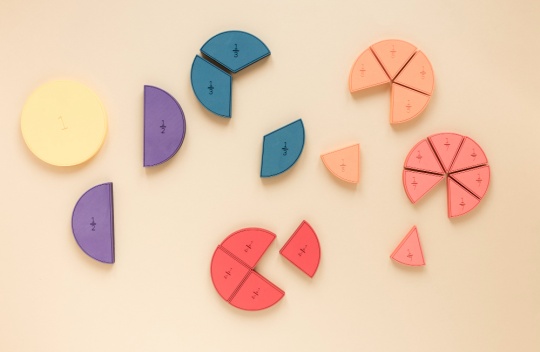
Fractions are one of the fundamental mathematical concepts we use daily to represent parts of a whole. Whether dividing a pizza, calculating discounts, or measuring ingredients in a recipe, fractions allow us to express partial quantities in a precise and mathematical manner.
What Are Fractions?
A fraction is a mathematical expression that represents a quantity divided into equal parts. It consists of two numbers separated by a horizontal or diagonal line: the numerator (top number) indicates how many parts we take, and the denominator (bottom number) indicates how many equal parts the total has been divided into. For example, when we divide a pizza into 8 equal slices and take 3 of them, this is represented as 3/8. This representation allows us to work mathematically with parts of a whole in a precise and systematic way.
Types of Fractions
Fractions can be classified into different types based on the relationship between their numerator and denominator. Each type has specific characteristics that help us better understand its value and application in everyday situations. Understanding these types is fundamental for working with fractions effectively, whether in basic mathematics or practical day-to-day applications.
1. Proper Fractions
Proper fractions are those where the numerator is less than the denominator, thus representing a quantity less than one unit. For example, 2/5, 3/8, or 5/6 are proper fractions, as in each case the top number is less than the bottom number.
Examples of Proper Fractions
Proper fractions are very common in everyday life, when we need to express parts smaller than a whole:
- Half a pizza: 1/2 of a whole pizza
- Three-quarters of a cup of sugar: 3/4 of a cup
- One-third of a pound of ground beef: 1/3 lb
- A quarter of an hour: 1/4 of an hour (15 minutes)
2. Improper Fractions
In improper fractions, the numerator is greater than the denominator, which means they represent quantities greater than one unit. Some examples are 8/5, 7/4, or 9/6. These fractions can always be expressed as mixed numbers.
Examples of Improper Fractions
Improper fractions appear when we need more than one complete unit:
- 7/4 of a pound of cheese: equivalent to 1 pound and 3/4 of cheese
- 5/2 of a quart of milk: equivalent to 2 and a half quarts
- 9/4 of a yard of fabric: equivalent to 2 and a quarter yards
- 8/3 of an hour: equivalent to 2 hours and 40 minutes
3. Mixed Fractions
A mixed fraction combines a whole number with a proper fraction. For example, 2 3/4 represents two whole units plus three-quarters. Mixed fractions are another way of writing improper fractions - for instance, 2 3/4 is equivalent to 11/4.
Examples of Mixed Fractions
Mixed fractions are especially useful in practical measurements:
- 2 1/2 cups of all-purpose flour: two and a half cups
- 1 3/4 pounds of ground beef: one and three-quarters pounds
- 3 1/3 feet of rope: three and one-third feet
- 4 1/2 hours of road trip: four and a half hours
4. Equivalent Fractions
Equivalent fractions are those that represent the same quantity even though they are written differently. For example, 1/2, 2/4, and 4/8 are equivalent fractions because they all represent the same portion of a whole. They are obtained by multiplying or dividing both the numerator and denominator by the same number.
Examples of Equivalent Fractions
Equivalent fractions represent the same quantity but using different values:
When cutting a pie:
- 1/2 = 2/4 = 4/8 (all represent half of the pie)
- 2/3 = 4/6 = 6/9 (all represent two-thirds of the pie)
In time measurements:
- 30/60 = 1/2 hour (half an hour)
- 15/60 = 1/4 hour (a quarter of an hour)
Operations and Calculations with Fractions
While the different types of fractions are fundamental mathematical concepts, performing operations with them can be challenging. Basic operations with fractions include addition, subtraction, multiplication, and division. To add or subtract fractions, we need them to have the same denominator. If they are different, we must first find a common denominator. Multiplication is performed by multiplying numerators together and denominators together, while for division, we multiply by the reciprocal of the second fraction.
These operations can become more complex when working with fractions of different denominators or when we need to perform multiple calculations. For example, to add 2/3 + 3/4, we first need to find a common denominator by multiplying 3 × 4 = 12. Then, we adjust the numerators: (2 × 4)/(3 × 4) + (3 × 3)/(4 × 3) = 8/12 + 9/12 = 17/12, which can also be expressed as 1 5/12. To simplify this process, we can use a fraction calculator, which performs these calculations automatically and shows us the result in its simplest form.
Mastering the Art of Mathematics
Handling fractions is an essential skill that transcends the math classroom. In our daily lives, fractions help us make precise decisions, from splitting a restaurant bill to calculating discounts on purchases. Understanding them allows us to interpret cooking recipes, measure ingredients accurately, and solve practical problems involving divisions and proportions. By mastering the different types of fractions and their applications, we develop a fundamental mathematical tool that accompanies us in countless situations in our daily lives.
